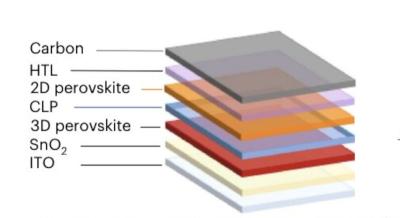Perovskite-Info weekly newsletter
Published: Tue, 03/14/23
The Perovskite-Info newsletter (March 14, 2023)
Cannot read this? View it online here
EU's Project SUNREY targets sustainable and efficient perovskite solar cells with reduced lead content
Project SUNREY (”Boosting SUstaiNability, Reliability and EfficiencY of perovskite PV through novel materials and process engineering”) is a three-year project which started on November 1, 2022. It is coordinated by the Fraunhofer Institute for Applied Polymer Research IAP in Potsdam, Germany. The project aims to further the development of highly-efficient solar cells based on non-critical raw materials (with a focus on making perovskite solar cells more sustainable, efficient and durable) and to strengthen the innovation potential of the European industry.
SUNREY is funded by the European Union’s research and innovation program Horizon Europe within the framework of the Green Deal Initiative with 4.25 Million Euro.
Researchers develop strategy to stabilize 3D/2D perovskites for better solar cells
Researchers at Huazhong University of Science and Technology, Wuhan University of Technology and University of Toronto recently introduced a new approach for fabricating more stable 3D/2D heterostructures, preventing their degradation. Their approach is based on the introduction of an additional layer between the structures; 3D and 2D perovskite layers.
2D and quasi-2D modified 3D perovskite heterostructures (i.e., structures comprised of 3D and 2D perovskite materials) have several advantageous qualities, such as enabling the passivation of defects and a favorable band alignment, which improve a perovskite solar cells' open-change voltage and fill factor. 3D/2D heterostructures are typically created by spin coating an organic cation salt solution on top of a 3D perovskite material and forming a thin 2D perovskite layer on its surface. This process, however, can facilitate the subsequent degradation of the heterostructures in some conditions, due to the diffusion of ions between the 2D perovskite surface and underlying bulk 3D perovskite.
Researchers develop perovskite-based memristors that are more powerful and easier to manufacture
The human brain can effortlessly process complex sensory information and learn from experiences, while a computer cannot. And, the brain does all this by consuming less than half as much energy as a laptop. One of the reasons for the brain's energy efficiency is its structure. The individual brain cells – the neurons and their connections, the synapses – can both store and process information. In computers, however, the memory is separate from the processor, and data must be transported back and forth between these two components. The speed of this transfer is limited, which can slow down the whole computer when working with large amounts of data.
One possible solution to this problem are novel computer architectures that are modeled after the human brain. To this end, scientists are developing 'memristors': components that, like brain cells, combine data storage and processing. A team of researchers from Empa, ETH Zurich and the Politecnico di Milano has developed a memristor based on perovskite materials that is more powerful and easier to manufacture than its predecessors.
Researchers use Ruddlesden-Popper perovskites for improved solar cells
Scientists China's Zhengzhou University, Xi'an Jiaotong University and Chinese Academy of Sciences (CAS) have designed a solar cell based on low-dimensional Ruddlesden-Popper (LPDR) perovskite that is said to have improved carrier transport properties.
The team explained that the new cells are more stable compared to regular 3D perovskite solar cells and are suitable for building-integrated photovoltaics (BIPV), conventional solar, and wearable devices.
Researchers report a new method to fabricate large-scale high-quality perovskite single crystal arrays
Researchers from the Chinese Academy of Sciences (CAS), Anhui University, Ocean University of China and Peking University have reported a one-step space confinement and antisolvent-assisted crystallization (SC-ASC) strategy for large-scale high-quality perovskite single crystal array for optoelectronic device integration.
MAPbBr3 MPs array fabricated on the 10 × 10 cm glass
This method provides comprehensive control over the perovskite single crystal array, including the array shape and resolution with crystal dimension and position accuracy as well as the in-plane rotation of the individual single crystal in a large-scale array configuration.
Ascent Solar Technologies repurposes its solar facility to advance perovskite solar commercialization
Ascent Solar Technologies, a U.S. manufacturer of lightweight, flexible and durable CIGS thin-film photovoltaic (PV) solutions, has announced that it has commissioned its Thornton manufacturing facility as a Perovskite Center of Excellence (COE). Effective immediately, the facility will be dedicated to the industrial commercialization of Ascent’s patent-pending perovskite solar technologies that are reportedly demonstrating lab efficiencies above 20%.
Ascent has dedicated its Thornton facility to the purpose of Perovskite manufacturing development, and to the conversion of the Company’s patent-pending Perovskite solar technology to industrial scale. The COE is resourced by a dedicated team of experts spanning Research, Development, Manufacturing and Operations; USD $30 million of industrial equipment at original cost; Ascent’s patent-pending Perovskites intellectual property; and operational facilities with 17 years of manufacturing heritage.
Researchers develop strategy to reduce the formation of anions vacancy defects in halide perovskite solar cells
Researchers at China's Shaanxi Normal University and Chinese Academy of Sciences (CAS) have designed a novel strategy to reduce the formation of anions vacancy defects in halide perovskite solar cells. The team reported that the new approach results in higher efficiency and remarkable stability.
The new method, which they defined as 'a one-stone-for-two-birds' strategy, utilized a ligand known as 3-amidinopyridine (3AP) to pin anions in the device. Anions can control the nucleation and growth of the perovskite crystals and act as a passivating agent to improve the crystallinity, thus ensuring improved efficiency. The team says the 3AP molecules deposited on the perovskite layer are able to form strong chemical bonds with the cell's lead(II) iodide (Pb–I) interlayer and, as a consequence, create a sustainable pinning effect.
Metalgrass LTD
9 Har Tsin St.
Kfar Sava Hasharon 4430809
ISRAEL
Unsubscribe | Change Subscriber Options









